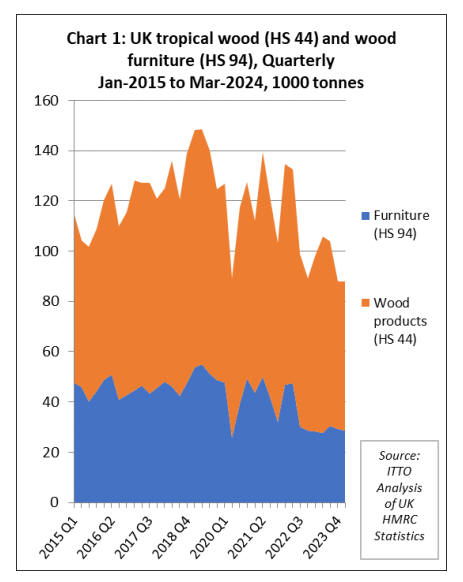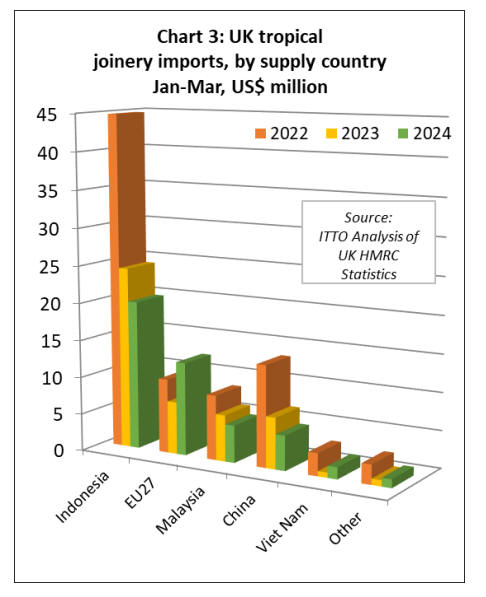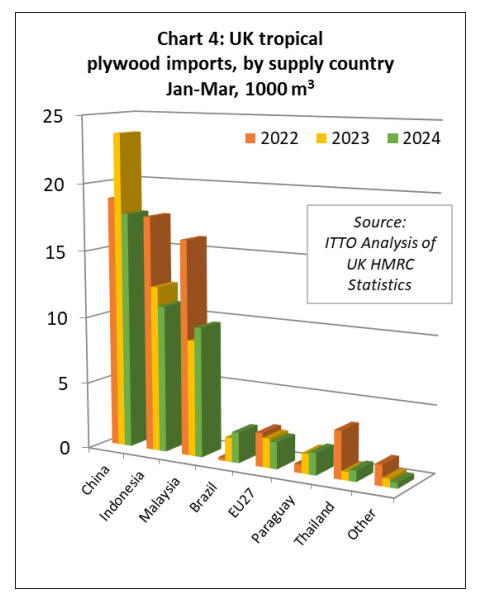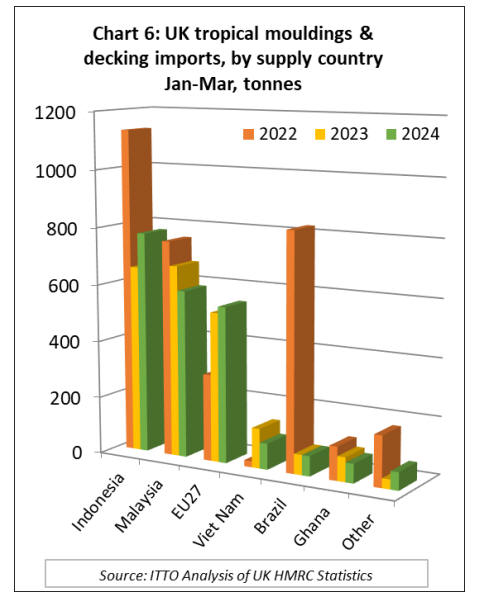|
Report from
Europe
Weak start to the year for UK imports but economic
outlook is improving
After hitting an all-time low in 2023, UK imports of
tropical wood products remained very weak in the first
quarter this year. However, the outlook is improving as the
UK economy grew at the fastest rate in nearly three years
between January and March 2024, ending the shallow
recession it entered in the second half of last year.
The UK imported 87,970 tonnes of tropical wood and
wood furniture products with a total value of $223 million
in Q1 2024. In tonnage terms, this was 10% less than Q1
2023 and just 0.2% more than the record low recorded in
the last quarter of 2023 (Chart 1).

Import value in Q1 2024 was down 5% compared to Q1
2023 but 3% higher than the previous quarter.
The good news is that, according to the UK Office for
National Statistics, national GDP expanded by 0.6% in the
first quarter this year, the strongest growth since the fourth
quarter of 2021 when it rose by 1.5%. The first-quarter
growth exceeded all forecasts in a Reuters poll of 39
economists which had pointed to a 0.4% expansion of
GDP in the January-to-March period, after GDP shrank by
0.3% in the final quarter of 2023.
The improved GDP figures reinforce more positive news
from the construction sector. UK construction activity beat
expectations in April, growing at its fastest pace for more
than a year as a brighter economic outlook boosted
commercial and civil engineering sectors.
The S&P Global UK Construction Purchasing Managers’
Index rose to 53 in April, up from 50.2 in March and the
highest reading since February 2023. The figure surpassed
the 50.2 forecast by economists polled by Reuters and
stood above the 50 mark, which indicates rising output.
The Bank of England’s Monetary Policy Committee
(MPC), which held interest rates at a 16-year high of
5.25% at their meeting on 8 May, had forecast quarterly
growth of 0.4% for the first quarter and a smaller 0.2%
rise for the second quarter, and a weak expansion of just
0.5% for 2024 as a whole. MPC officials had signalled the
central bank could shift to cutting rates as early as June.
However, some economists now believe that stronger
GDP growth could stoke inflation and that the MPC may
have to maintain higher rates for longer.The UK economic
data is rather less encouraging when viewed on a per
capita basis.
Although UK GDP per head rose for the first time in two
years in the first quarter, up 0.4%, it was still 0.7% lower
than a year earlier, highlighting the ongoing squeeze on
living standards and Britain's struggle to boost
productivity.
The economic news is better but the UK economy remains
fragile and prospects are still uncertain. "Despite the better
near-term outlook, the improvement in GDP growth looks
likely to be constrained by the ongoing weakness in
productivity growth as well as reduced scope to increase
employment levels," Yael Selfin, chief economist at
KPMG UK, said.
UK imports of tropical wood furniture down from all
countries except Malaysia
UK imports of wood furniture products from tropical
countries remained weak in the first quarter this year. The
UK imported USD105 million of these products during the
January to March period this year, 2% less than the same
period in 2023. In quantity terms, wood furniture imports
were 28,600 tonnes in the first quarter of 2024, 1% more
than the same period in 2023.
In Q1 2024 compared to Q1 2023, UK wood furniture
import value increased from Malaysia (+20% to USD26.9
million), but decreased for all other leading supply
countries including Vietnam (-4% to USD54.7 million),
India (-10% to USD26.9 million), Indonesia (-5% to
USD8.9 million), Singapore (-26% to USD1.9 million),
and Thailand (-39% to USD1.8 million) (Chart 2).

Rising UK imports of tropical hardwood joinery
products from EU countries
In the first quarter this year, the UK imported 14,900
tonnes of tropical joinery products with value of USD44.8
million, respectively 12% and 2% less than the same
period in 2023.

A large rise in imports of joinery products made with
tropical wood from the EU (+78% to USD12.5 million)
and a recovery in imports from Vietnam (+132% to
USD1.6 million) offset falling imports from Indonesia
(down 18% to USD19.9 million), Malaysia (down 19% to
USD5.0 million) and China (down 32% to USD4.7
million) (Chart 3).
UK imports of tropical hardwood plywood down 12% in
the first quarter
In the first quarter of 2024, the UK imported 45,500 m3 of
tropical hardwood plywood, 12% less than the same
period last year. Import value declined 10% to USD27.2
million. UK imports of plywood with a tropical hardwood
face veneer from China were 17,700 m3 in the first quarter
this year, 25% less than the same period in 2023.
Tropical hardwood plywood imports from Indonesia fell
11% to 11,000 m3 in the first quarter, while indirect
imports from the EU were down 10% to 2,000 m3.
However, hardwood plywood imports increased from
Malaysia (+12% to 9,700 m3), Brazil (+26% to 2,300 m3),
Paraguay (+10% to 1,600 m3) and Thailand (+28% to 800
m3) during the period (Chart 4).

Sharp drop in UK imports of tropical sawnwood from
Cameroon and the EU this year
UK imports of tropical sawnwood were 20,600 m3 in the
first quarter of 2024, 27% less than the first quarter of
2023. Import value was USD25.4 million in the first three
months this year, 14% less than the same period in 2023.
Imports from Cameroon were down 36% to 6,000 m3,
while indirect imports from the EU fell 23% to 5,700 m3.
Imports from Brazil also fell sharply, by 75% to 700 m3.
However, there were gains in UK imports of sawnwood
from Malaysia (+9% to 2,600 m3), Republic of Congo
(+41% to 2,000 m3), Ghana (+ 67% to 1,500 m3), and
Cote d’Ivoire (+26% to 600 m3) (Chart 5).

The UK imported 2200 tonnes of tropical hardwood
mouldings/decking with a total value of USD6.3 million in
the first quarter of 2024, a 1% gain in tonnage terms but a
3% decline in value 12% compared to the same period in
2023.
UK imports of tropical hardwood mouldings/decking
recovered ground from Indonesia in the first quarter this
year (+18% to 776 tonnes) and indirect imports from the
EU were also up 4% to 546 tonnes. However, imports
were down from Malaysia (-13% to 587 tonnes), Vietnam
(-35% to 91 tonnes), Brazil (-1% to 70 tonnes) and Ghana
(-21% to 67 tonnes) (Chart 6).

Further calls for delay to EU Deforestation Regulation
According to the Euractiv news agency, Austria’s
agriculture and economy ministers have urged European
Commission President Ursula von der Leyen to postpone
implementation of the new EU anti-deforestation
regulation (EUDR), scheduled for January 2025.
See report at:
(https://www.euractiv.com/section/agriculture-food/news/austrias-farming-economy-ministers-urge-von-der-leyen-to-delay-eu-anti-deforestation-law/),
Euractiv say the call for a delay came in a letter dated 27
April signed by Austria’s minister of agriculture, Norbert
Totschnig, and economy minister Martin Kocher,
addressed to von der Leyen and EU Commissioners Maroš
Šefčovič, Janusz Wojciechowski, and Virginijus
Sinkevičius.
Euractiv report that the Austrian officials claimed that the
looming implementation of the EUDR presents
“insurmountable challenges” for the responsible Austrian
authorities and affected businesses.
They attributed these difficulties to “unnecessary
bureaucratic hurdles” that EU countries would face if the
rules were enforced without classifying countries or
regions into three different categories (high, standard and
low) based on the risk of deforestation.
Under the new rules, shipments coming from higher-risk
countries will be subject to stricter checks, while
requirements for buyers sourcing products from low-risk
regions will be simplified. However, the Austrian officials
noted that in 2025 all countries — including EU member
states — may fall under the standard risk category since
the Commission has hinted at postponing the initial
classification until next year.
According to Euractiv, the Austrian representatives wrote:
“The lack of classification by the EC [European
Commission] for low-risk countries means
disproportionately higher control efforts and increased due
diligence obligations for all market participants.”
The Austrian officials claimed that their proposal received
backing from 22 EU countries, including Finland, Italy,
Poland, Slovakia, Slovenia, and Sweden, during a Council
meeting in March.
Euractiv go on to note that several farming ministers,
including representatives from Germany and Latvia,
echoed the calls during meeting of the EU Agriculture and
Fisheries (AGRIFISH) Council on 29 April.
The president of the EU AGRIFISH Council, Belgian
minister David Clarinval, told Euractiv that over a dozen
member states had voiced support for delaying the
implementation of the EUDR.
Meanwhile, EU Agriculture Commissioner Janusz
Wojciechowski stated that he would advocate for
postponing the implementation of the rules for an
additional year within the Commission. “I presented into
the internal work of the Commission support for this
proposal, and I think it is needed,“ Wojciechowski told
Euractiv.
As previously noted in the ITTO Tropical Timber Market
Report (ITTO TTMR: 28:6 16–31 March 2024), while
these calls are being made for a delay to EUDR
implementation, there are significant legal and political
obstacles to these being acted upon. Since the EUDR has
already been enacted (on 31 May 2023) and published in
the Official Journal of the EU, any postponement will
require a new legislative procedure involving the
Parliament, Commission and Council.
The responsible European Commission agency (DG ENV)
has not indicated any intention to delay implementation.
Environmental non-governmental organisations are also
very actively lobbying in Brussels against any moves to
delay or amend the law.
Science and AI join in battle against illegal trade
Latest research and the investigation into a consignment of
Russian birch plywood shipped into Belgium point to
science-based traceability methods becoming increasingly
important tools in combating illegal timber trade,
according to a New York Times (NYT) report.
The NYT article in April reviewed a paper in Nature
Plants on development by science-based tree and plant
traceability specialist World Forest ID (WFID) of a model
to establish plant origin across wide areas in the fight
against illegal logging and in enforcement of sanctions.
The project, using stable isotope ratio analysis (SIRA) and
trace element analysis (TEA), was tailored to identify
timber from Russia and Belarus. The EU imposed a trade
embargo on this following the invasion of Ukraine, but it
is still suspected of entering the market via intermediary
countries.
NYT report that Turkey’s imports of Russian plywood
increased 240% in 2022, and by a further 595% in the first
half of 2023, compared to the same period the previous
year. The Russian imports of the UAE, Singapore, Hong
Kong, and Georgia also increased significantly in this
period.
At the same time, EU imports from these third countries
have seen dramatic hikes. They supplied the EU27 with
more than 1 million kg of plywood in the first six months
of 2023, an increase of 100% on the same period in 2022.
Most notable was the 5,000% increase in plywood imports
from Kazakhstan and 137% increase from Turkey.
According to the NYT, the science-based timber
traceability project involved teams of researchers from
certification body and sustainable business and land
management non-profit consultancy Preferred by Nature
under the direction of WFID Chief Scientist Victor
Deklerck.
They collected thousands of ‘ground-truthed’ samples of
the seven most highly traded timber species across 11
countries in Central and Eastern Europe, including birch.
The aim was that these could be used to compare with and
identify the origin of timber in the marketplace.
A combination of SIRA and TEA were used on the
samples effectively to provide a ‘chemical fingerprint’ for
each one. This can be used to identify origin as the local
environment and soil composition where timber grows
shapes their ‘fingerprint’.
“SIRA and TEA are often represented as alternative or
competing techniques for establishing product origin,”
said WFID in a briefing note on the Nature Plant paper.
“However, by comparing and combining reference data
from both, the study demonstrates that optimal results are
achieved by fusing multiple data types into a single
reference model.”
To expand the scope and value of this approach, the next
step was to develop a system that could extrapolate the
species identification to areas where samples had not been
collected. This meant assessing the probability of timber
from these having a similar fingerprint to samples taken
elsewhere.
To do this, Jakub Truszkowski, an expert in machine
learning (an application of AI) at the University of
Gothenburg devised a special model using the samples
collected by PbN. “Powerful computer clusters allowed Dr
Truszkowski to extrapolate chemical profiles for vast
expanses of forest across Eastern Europe from which no
samples had been taken,” says the NYT report.
The Nature Plant paper says that the AI process was
applied using 22 ‘ground-truthed’ chemical values from
929 of the geolocated samples, extracted from standing
trees across the commercial range of the species.
Combining its proof of provenance model with AI, stated
WFID, made science-based timber analysis both more
practical and affordable.
“While geolocated physical samples are the foundation of
our approach, sampling the number of locations necessary
to achieve comprehensive spatial results is resource
intensive,” it says. “In addition, ideal collection
coordinates can correspond with areas that are in political
conflict or otherwise unsafe for sample collectors.
The [AI] approach captures spatial variability by
employing precise GPS data for reference locations,
creating a landscape-reflective ‘origin model’, allowing it
to effectively infer chemical profiles in unsampled areas.
In this way, it transcends traditional statistical models and
arbitrary political boundaries. Enriched with a wealth of
freely available environmental and climatic datasets, it can
significantly increase the scope and range of reference
data, at reduced marginal cost.”
The approach is seen as readily applicable by national and
regional authorities in enforcing anti-illegal and
unsustainable timber and plant market regulations,
including the EU Deforestation Regulation (EUDR).
‘There is an extensive body of evidence showing that the
effectiveness of global timber trade controls has been
undermined by ’laundering’ of illegal products, using
documents purporting to show harvest in legal and/or
certified sustainable areas,” states WFID. “Mainstreaming
accurate scientific testing for geolocation verification will
be critical to ensure that the effectiveness of the EUDR,
and similar potential regulations in other markets, is not
compromised in the same way.”
According to the NYT report, overall the research project
caught 60% of the samples that had been intentionally
labelled with the wrong country of origin. “It could also
narrow the wood’s origin to a roughly 125-mile radius, a
remarkable feat in a continent that’s roughly 40 percent
covered by forest,” it said.
The WFID model’s capability to pinpoint a wood sample’s
origin differed from country to country. “It managed to
flag 82% of wood originating in Russia (and disguised as
originating elsewhere), but only 47% of samples from
Belarus,” reported the NYT. Dr Truszkowski said the
success rate would improve as more wood samples were
collected.
In a separate development, use of isotope testing on 261
tonnes of birch plywood seized by the Belgian Federal
Environmental Service (FSP) earlier this year, showed it
was from Russia. Belgian newspaper De Tijd reported
early March that the plywood was tested at the Royal
Museum for Central Africa (KMMA) in Tervuren.
The NYT concluded that the WFID project is “a kind of
proof of concept for the researchers, showing that it was
possible for science to respond to real-world needs, and to
do so in a timely manner”.
Clarification
In response to the text captioned "Certification schemes
lay out EUDR compliance support" in the 16-30 April
Market Report an executive from PEFC offered the
following clarifications and a correction.
First clarification relating to alignment of PEFC
standards with EUDR
A PEFC Sustainable Forest Management Working Group
has worked on identifying and validating gaps between the
PEFC SFM standards and EUDR requirements. The
updated SFM benchmark standard designed to close these
gaps is due to go out for consultation in May for 60 days.
A PEFC Chain of Custody Working Group (CoC WG)
has also been working to create a modular alignment
solution by analysing the EUDR requirements and
carrying out gap analysis. The updated CoC standard was
out for consultation until 7 May.
Second clarification on provision of geolocation data
in line with EUDR requirements
PEFC are looking to collaborate with commercial software
providers to allow owners/managers to upload geolocation
coordinates into the software company EUDR solutions.
Operators will have the responsibility to upload Due
Diligence Statements (DDS) and geolocation data to the
EU Information centre where they will receive a reference
number. DDS information, geolocation data and EU
reference numbers will be able to be shared appropriately
using commercial software company solutions. PEFC will
release details of partnerships in due course.
Correction relating to PEFC cut-of date
PEFC has not revised its deforestation/forest land
conversion cut-off date as we previously stated. PEFC is
putting out its international benchmark standard for public
consultation with the existing cut-off date and is inviting
comments.
Note that PEFC's existing standard does not allow
certification of a plantation established on land converted
from forest after 31 December 2010 (other than in certain
"justified circumstances" set out in the PEFC standard).
The EUDR requires that production of the regulated
commodity has not caused deforestation or forest
degradation since December 31, 2020.
More details of PEFC in relation to EUDR are available at
https://pefc.org/eudr
|